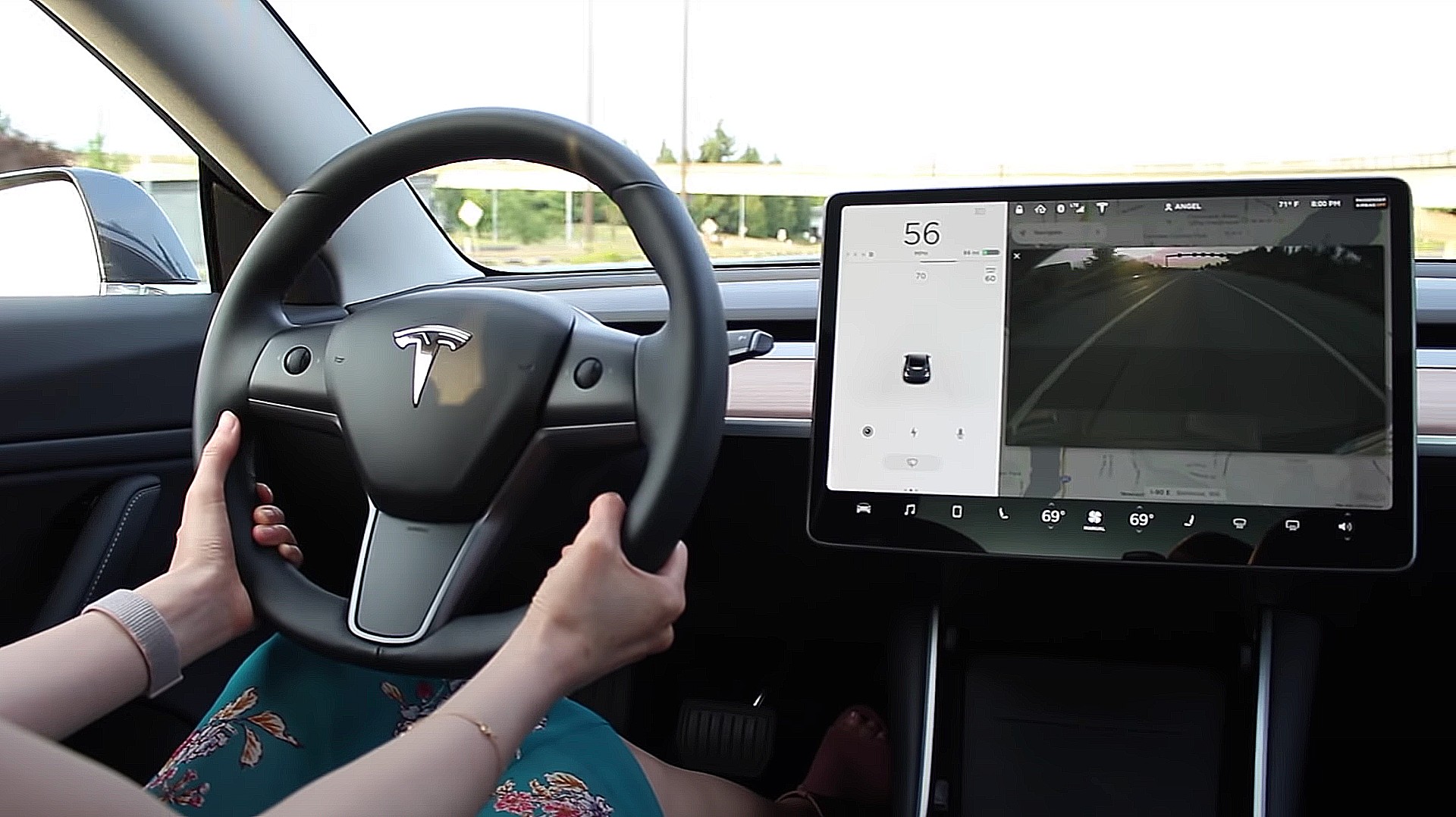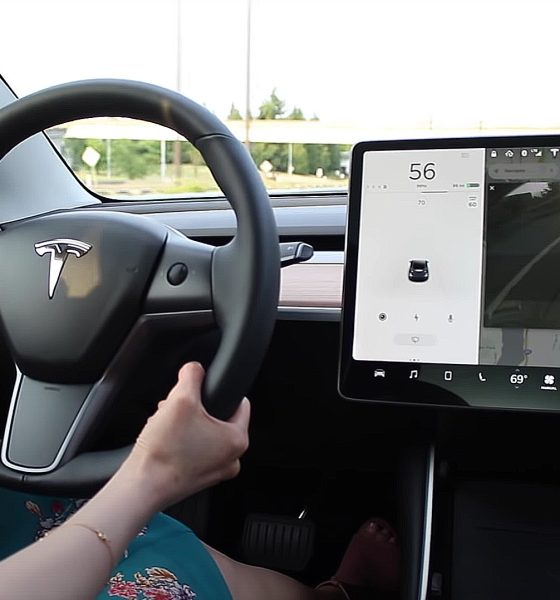

News
Watch Tesla Full Self-Driving Beta’s software operate without ‘rolling stops’
Tesla has rolled out Full Self-Driving Beta software version 10.10, which has eliminated the vehicle’s ability to perform “rolling stops.” The feature was required to be removed following a reprimand from the National Highway Traffic Safety Administration (NHTSA), who required Tesla to remove the feature from the Beta program via an update.
Earlier this week, the NHTSA required Tesla to recall 53,822 vehicles. The term recall is applicable here, according to the NHTSA. NHTSA recalls can include any required repair, which includes a software update, to remedy a potential safety risk. Software updates, while performed from the comfort of a garage or parking space, are still technically considered a recall as they are a manufacturer remedy to a problem that could cause a risk to safety.
The recall applies to Model S and Model X vehicles built from 2016 to 2022, Model 3s from 2017 to 2022, and Model Ys from 2020 to 2022.
Tesla stated that it would remedy the issue with a software update. The FSD Beta 10.10 release notes are as follows:
– Smoother fork maneuvers and turn-lane selection using high fidelity trajectory primitives.
– Disabled rolling-stop functionality in all FSD Profiles. This behavior used to allow the vehicle to roll through all-way-stop intersections, but only when several conditions were met, including: vehicle speed less than 5.6 mph, no relevant objects/pedestrians/bicyclists detected, sufficient visibility and all entering roads at the intersection have speed limits below 30 mph.
– Improved generalized static object network by 4% using improved ground truth trajectories.
– Improved smoothness when stopping for crossing objects at intersections by modeling soft and hard constraints to better represent urgency of the slowdown.
– Enabled lane changing into an oncoming lane to maneuver around static obstacles, when safe to do so.
– Improved smoothness for merge handling by enforcing more consistency with previous cycle’s speed control decisions.
– Improved handling of flashing red light traffic controls by adding more caution for events where crossing vehicles may not stop.
– Improved right of way understanding at intersections with better modeling of intersection extents.
The Full Self-Driving Beta’s “rolling stop” feature was designed to allow vehicles to travel through an all-way-stop intersection while maintaining speeds between 0.1 and 5.6 MPH. According to the NHTSA’s Safety Recall Report, Tesla met with the NHTSA met on January 19 to discuss the “rolling stop” feature and all of its related details. Tesla made the voluntary decision to disable the feature on January 20, 2022. The NHTSA stated that its main concern was “Entering an all-way-stop intersection without coming to a complete stop may increase the risk of collision.” Additionally, the agency said that “Tesla is not aware of any collisions, injuries or fatalities related to this condition.”
Tesla recently stated that its Beta program had exceeded 60,000 vehicles.
Check out the first videos of the new FSD Beta Version 10.10 update below, courtesy of owner James Locke.
Update 2:43 PM 2/7/2022: Second paragraph revised for accuracy. NHTSA definition of “recall” includes issues that could be remedied by software updates.

News
Tesla FSD fleet is nearing 7 billion total miles, including 2.5 billion city miles
As can be seen on Tesla’s official FSD webpage, vehicles equipped with the system have now navigated over 6.99 billion miles.

Tesla’s Full Self-Driving (Supervised) fleet is closing in on almost 7 billion total miles driven, as per data posted by the company on its official FSD webpage.
These figures hint at the massive scale of data fueling Tesla’s rapid FSD improvements, which have been quite notable as of late.
FSD mileage milestones
As can be seen on Tesla’s official FSD webpage, vehicles equipped with the system have now navigated over 6.99 billion miles. Tesla owner and avid FSD tester Whole Mars Catalog also shared a screenshot indicating that from the nearly 7 billion miles traveled by the FSD fleet, more than 2.5 billion miles were driven inside cities.
City miles are particularly valuable for complex urban scenarios like unprotected turns, pedestrian interactions, and traffic lights. This is also the difference-maker for FSD, as only complex solutions, such as Waymo’s self-driving taxis, operate similarly on inner-city streets. And even then, incidents such as the San Francisco blackouts have proven challenging for sensor-rich vehicles like Waymos.
Tesla’s data edge
Tesla has a number of advantages in the autonomous vehicle sector, one of which is the size of its fleet and the number of vehicles training FSD on real-world roads. Tesla’s nearly 7 billion FSD miles then allow the company to roll out updates that make its vehicles behave like they are being driven by experienced drivers, even if they are operating on their own.
So notable are Tesla’s improvements to FSD that NVIDIA Director of Robotics Jim Fan, after experiencing FSD v14, noted that the system is the first AI that passes what he described as a “Physical Turing Test.”
“Despite knowing exactly how robot learning works, I still find it magical watching the steering wheel turn by itself. First it feels surreal, next it becomes routine. Then, like the smartphone, taking it away actively hurts. This is how humanity gets rewired and glued to god-like technologies,” Fan wrote in a post on X.
News
Tesla starts showing how FSD will change lives in Europe
Local officials tested the system on narrow country roads and were impressed by FSD’s smooth, human-like driving, with some calling the service a game-changer for everyday life in areas that are far from urban centers.

Tesla has launched Europe’s first public shuttle service using Full Self-Driving (Supervised) in the rural Eifelkreis Bitburg-Prüm region of Germany, demonstrating how the technology can restore independence and mobility for people who struggle with limited transport options.
Local officials tested the system on narrow country roads and were impressed by FSD’s smooth, human-like driving, with some calling the service a game-changer for everyday life in areas that are far from urban centers.
Officials see real impact on rural residents
Arzfeld Mayor Johannes Kuhl and District Administrator Andreas Kruppert personally tested the Tesla shuttle service. This allowed them to see just how well FSD navigated winding lanes and rural roads confidently. Kruppert said, “Autonomous driving sounds like science fiction to many, but we simply see here that it works totally well in rural regions too.” Kuhl, for his part, also noted that FSD “feels like a very experienced driver.”
The pilot complements the area’s “Citizen Bus” program, which provides on-demand rides for elderly residents who can no longer drive themselves. Tesla Europe shared a video of a demonstration of the service, highlighting how FSD gives people their freedom back, even in places where public transport is not as prevalent.
What the Ministry for Economic Affairs and Transport says
Rhineland-Palatinate’s Minister Daniela Schmitt supported the project, praising the collaboration that made this “first of its kind in Europe” possible. As per the ministry, the rural rollout for the service shows FSD’s potential beyond major cities, and it delivers tangible benefits like grocery runs, doctor visits, and social connections for isolated residents.
“Reliable and flexible mobility is especially vital in rural areas. With the launch of a shuttle service using self-driving vehicles (FSD supervised) by Tesla in the Eifelkreis Bitburg-Prüm, an innovative pilot project is now getting underway that complements local community bus services. It is the first project of its kind in Europe.
“The result is a real gain for rural mobility: greater accessibility, more flexibility and tangible benefits for everyday life. A strong signal for innovation, cooperation and future-oriented mobility beyond urban centers,” the ministry wrote in a LinkedIn post.
News
Tesla China quietly posts Robotaxi-related job listing
Tesla China is currently seeking a Low Voltage Electrical Engineer to work on circuit board design for the company’s autonomous vehicles.

Tesla has posted a new job listing in Shanghai explicitly tied to its Robotaxi program, fueling speculation that the company is preparing to launch its dedicated autonomous ride-hailing service in China.
As noted in the listing, Tesla China is currently seeking a Low Voltage Electrical Engineer to work on circuit board design for the company’s autonomous vehicles.
Robotaxi-specific role
The listing, which was shared on social media platform X by industry watcher @tslaming, suggested that Tesla China is looking to fill the role urgently. The job listing itself specifically mentions that the person hired for the role will be working on the Low Voltage Hardware team, which would design the circuit boards that would serve as the nervous system of the Robotaxi.
Key tasks for the role, as indicated in the job listing, include collaboration with PCB layout, firmware, mechanical, program management, and validation teams, among other responsibilities. The role is based in Shanghai.
China Robotaxi launch
China represents a massive potential market for robotaxis, with its dense urban centers and supportive policies in select cities. Tesla has limited permission to roll out FSD in the country, though despite this, its vehicles have been hailed as among the best in the market when it comes to autonomous features. So far, at least, it appears that China supports Tesla’s FSD and Robotaxi rollout.
This was hinted at in November, when Tesla brought the Cybercab to the 8th China International Import Expo (CIIE) in Shanghai, marking the first time that the autonomous two-seater was brought to the Asia-Pacific region. The vehicle, despite not having a release date in China, received a significant amount of interest among the event’s attendees.








